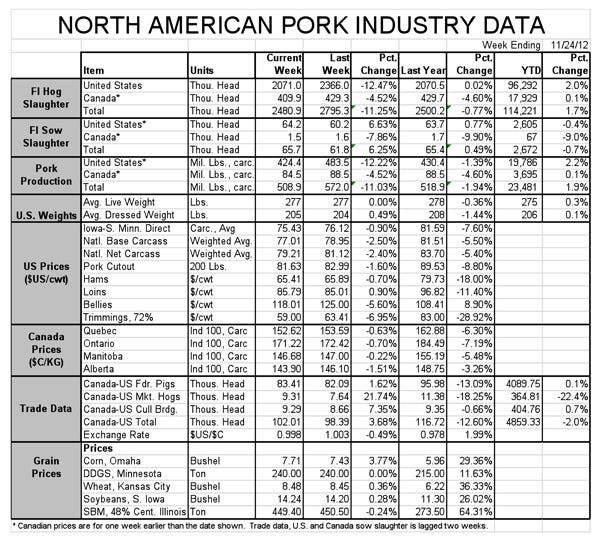Five Milestones that Shaped the U.S. Pork Industry
I guess the Thanksgiving holiday has me in a reflective mood. Either that or there just isn’t much in market news that is noteworthy today. Whatever the reason, I’ve decided to put down on paper what I think have been some of the milestones the pork industry has seen in the past 20 years or so.
November 26, 2012

I guess the Thanksgiving holiday has me in a reflective mood. Either that or there just isn’t much in market news that is noteworthy today. Whatever the reason, I’ve decided to put down on paper what I think have been some of the milestones the pork industry has seen in the past 20 years or so. While some will think these are achievements, others will equate them with mile-posts that have marked the road to demise. I think the achievements are far more numerous – with a few noted reservations.
Milestone No. 1 – the 1,000-head finishing building. While some may quibble over the capacity – 900 vs. 1,200 head – they were all around 1,000 and they marked a huge shift in technology and became the driver for farm sizes to come. Many new confinement finishing buildings were designed and tried in the 1980s, but most attempted to adopt key management practices, such as all-in/all-out, separate air spaces, controlled access to rooms to reduce group-to-group disease introduction. Smaller buildings or buildings with smaller rooms proved to be uneconomical when compared to the 1,000-head designs. I saw that first-hand when, in my role as an advisor to producers for a major feed company, I compared the cost of a building with four, 250-head rooms to one with 1,000 animals in one room. The multi-room building was 20% more expensive due to duplicated controllers, fans, curtain drives, cross walls, etc. It was clear to me that the business would move to the 1,000-head, single room buildings if producers could get enough pigs to fill them quickly. That was accomplished by increasing the size of sow farms.
Milestone No. 2 – early weaning: I may have this one out of order or its development may coincide with No. 1, but this practice was a big, big development for both the industry’s structure and performance. It is hard to believe that until the 1980s we thought the only way to get high health pigs was to take them by C-section and rear them on surrogate mothers in specific pathogen free (SPF) herds. That was a very costly and cumbersome proposition that could only be used in seedstock herds. The SPF animals posed less risk for disease introduction – at least for the diseases prevented by SPF protocols – but there was no guarantee that their offspring would remain healthy. The realization that high levels of maternal antibodies could protect young pigs if they were weaned earlier than the standard 4 to 8 weeks of age was a true revolution. Further, using the concept to successfully mix pigs from hundreds of farms during the NPPC’s Genetic Evaluation Program in the early- and mid-’90s proved that the little pigs were tough and could stand long shipment, early-weaning could indeed control disease, and early-weaning was something rank-and-file producers could do successfully.
Milestone No. 3 – Oceanview Farms’ lagoon failure: On June 21, 1995, one side of a lagoon at Oceanview Farms in North Carolina collapsed, sending a reported 20-million gallons of hog manure flowing into the headwaters of the New River. It was the first large environmental disaster in the hog industry that I can remember and it came at a time when the industry was changing rapidly. According to news reports, the area had received nearly 12 in. of rain the preceding two weeks. The farm was only a year-and-a-half old. Newspapers across the country – especially in Iowa and other Corn Belt states where producers were actively adopting “the North Carolina model” in one form or another – picked up the story and a picture of the gaping hole in the side of the lagoon. While environmental issues had been rising in importance for some time, this was, in my recollection, a defining moment that led to more scrutiny and increased regulation across the country. Of course, it also led to more awareness and care on the part of producers, resulting in a much better environmental record.
Milestone No. 4 – Smithfield Foods buys Carroll’s Foods and Murphy Family Farms. In February of 1999, Smithfield Foods announced it was buying Carroll’s Foods in a deal that added, according to Successful Farming’s 1998 Pork Powerhouses rankings, 183,600 sows to the 152,000 sows it already owned. That put Smithfield very near the 337,000 sows owned by Murphy Family Farms. Then in September of that year, Smithfield bought Murphy’s, creating the then-637,000-sow behemoth that is still the largest hog production company in the world. Carroll’s and Murphy’s had no doubt been weakened by the horrendous financial losses of 1998 and 1999, but we must also realize that this was a strategic move on the part of both companies. I have been told that Murphy’s did about everything they could to buy part of a packing plant or build their own during the mid-90s. I suspect that Carroll’s tried that approach as well. They, along with other eastern seaboard producers, almost convinced IBP to build a plant in South Carolina, but opposition groups and market conditions derailed that plan. News reports indicated that Carroll’s ended up with 3.3 million shares of Smithfield stock and Murphy’s landed about 10 million shares. While they indeed sold their production companies, the original owners ended up with substantial stakes in an integrated production, packing, processing and marketing company – exactly what they were trying to do in the first place.
Milestone No. 5 – H1N1 in 2009. This one is recent and painful. We got our first taste of what semantics (“swine flu”) and social media can do and it wasn’t pretty. We also saw how a disease might impact our business when this one wrongly impacted exports to China and Russia. And it wasn’t even a disease of pigs much less one that is viewed as trade-disrupting.
Obviously, there have been other major developments in this business – the 100% mandatory pork checkoff, carcass measurement and lean value pricing systems, Pork: The Other White Meat campaign, mandatory price reporting, the rise of the Humane Society of the United States (HSUS), to name a few. Let’s consider these carefully as we approach the end of 2012. It is often wise to review the lessons we have learned, as well as identify issues that we must handle in the future.


You May Also Like



